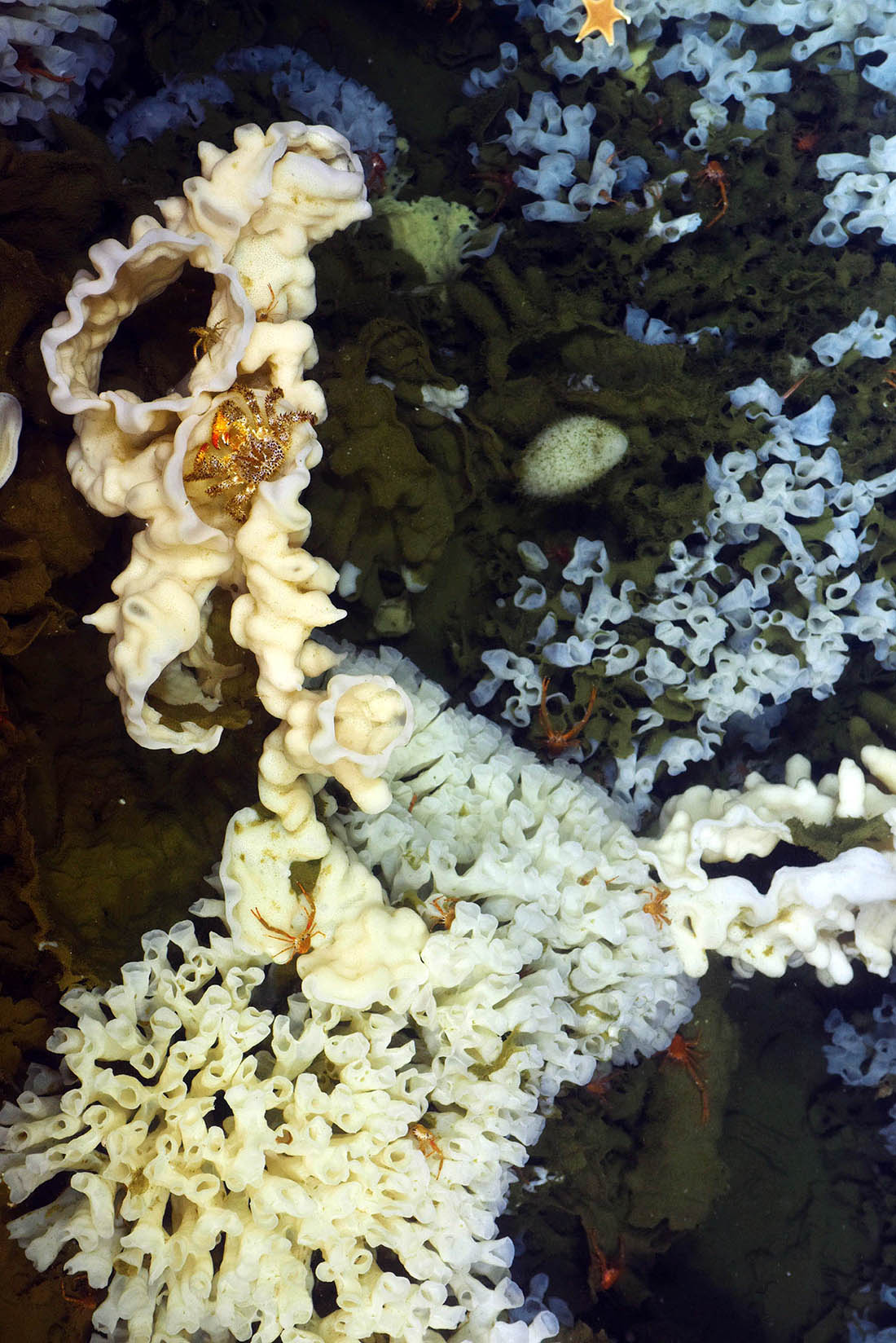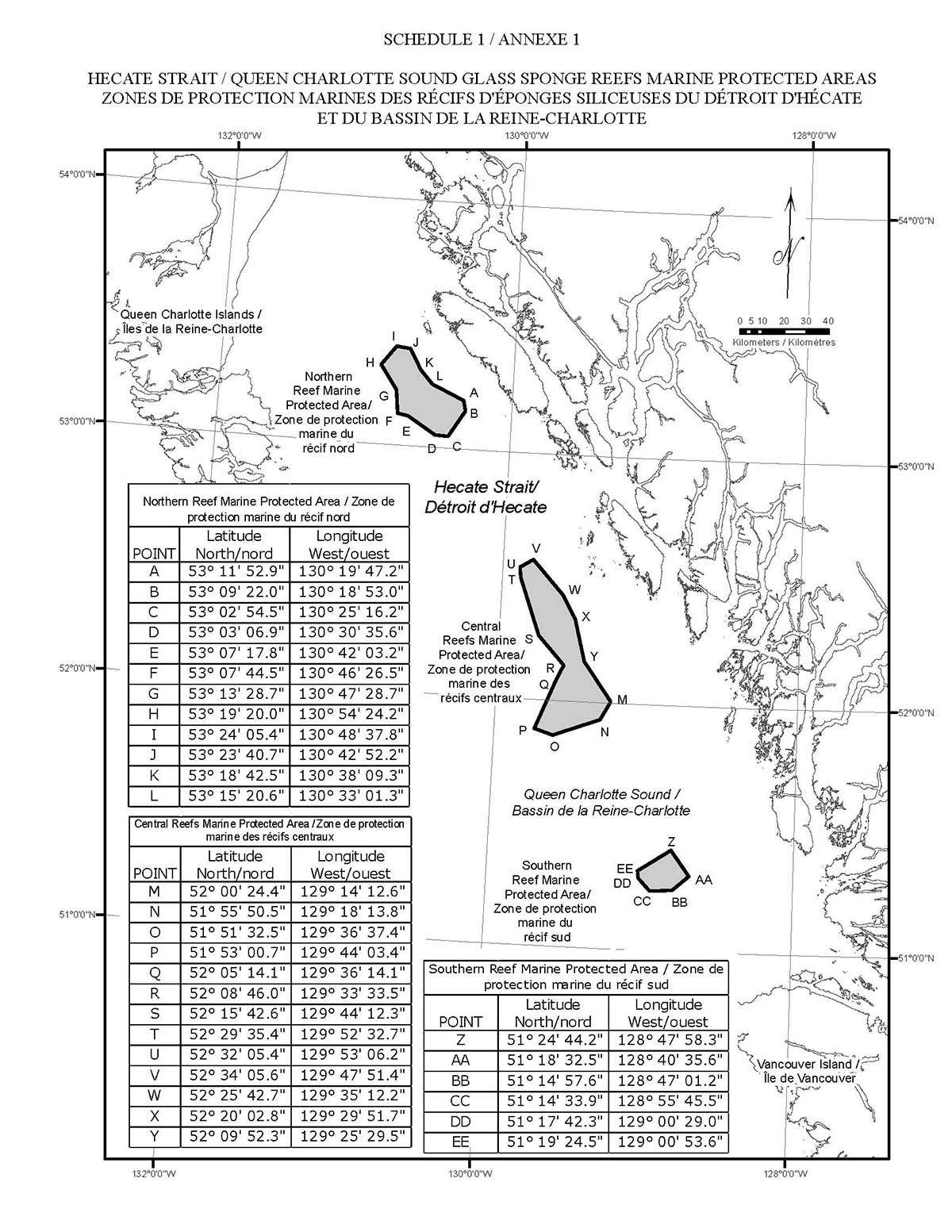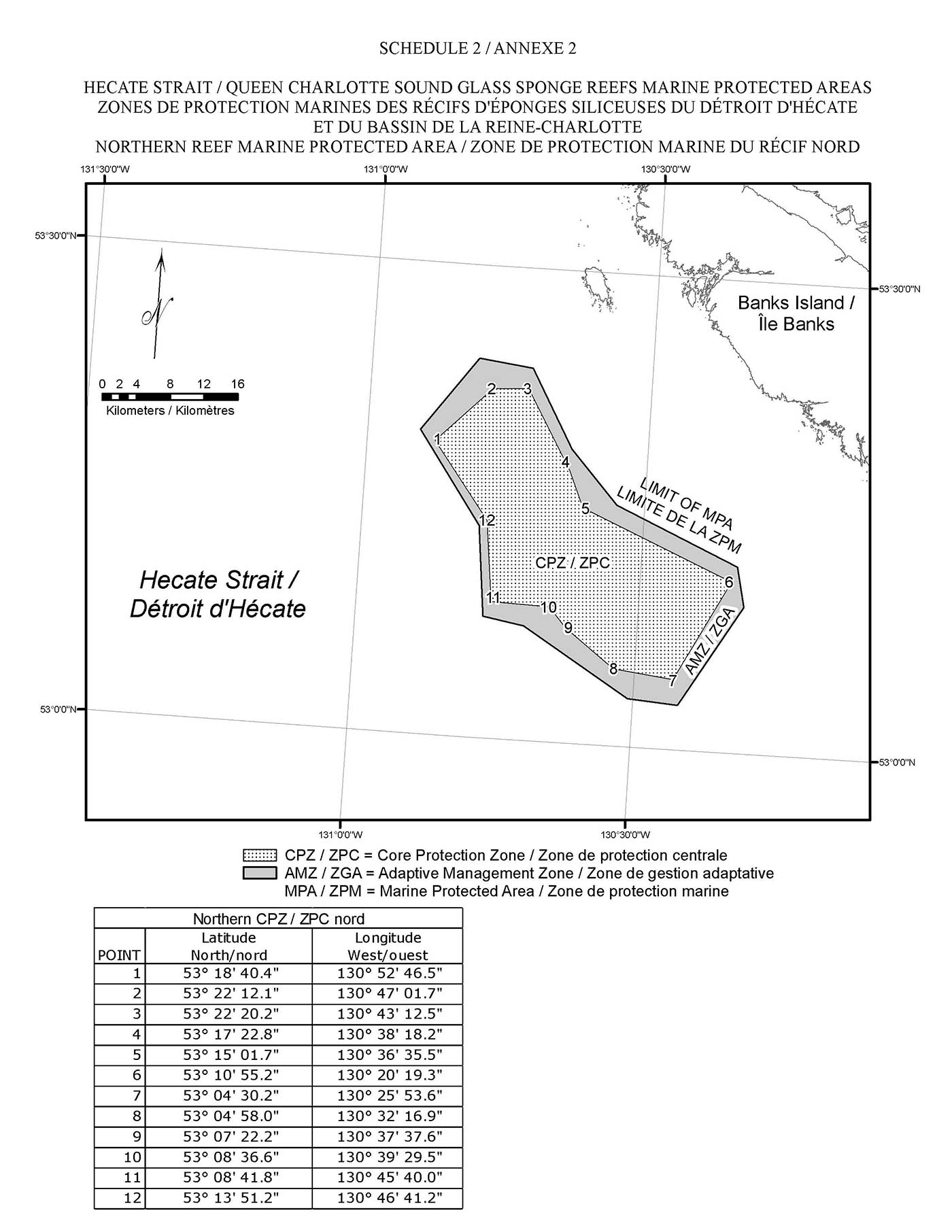Hecate Strait/Queen Charlotte Sound Glass Sponge Reefs Marine Protected Area (HS/QCS MPA)
Note:
Charts, diagrams and contact information on this website are provided for information purposes only and should not be used for fishing, navigation or other purposes. Please refer to the MPA Regulations or contact your regional Fisheries and Oceans Canada office for official coordinates.
On this page
At-a-glance
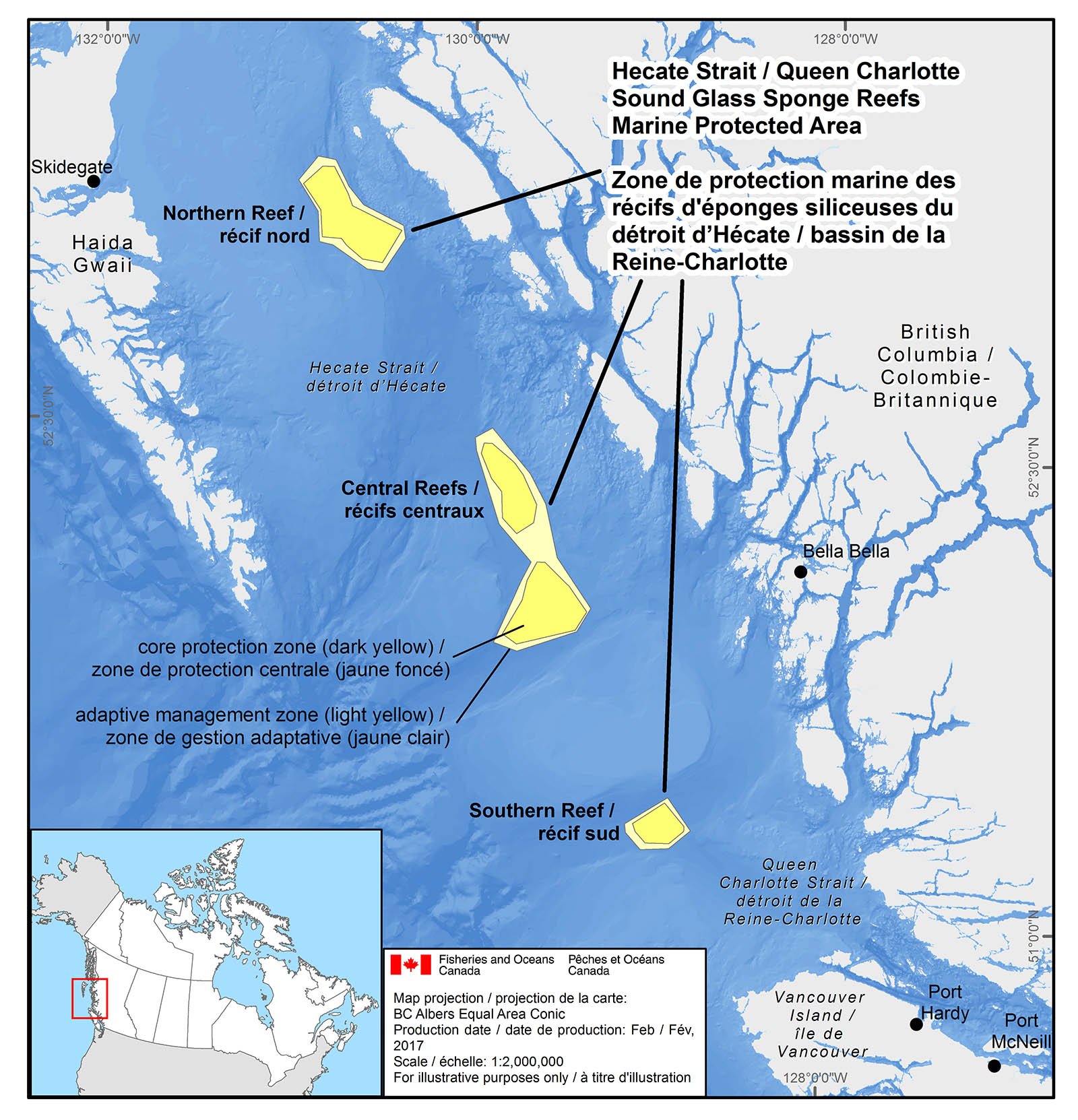
Map: Hecate Strait and Queen Charlotte Sound Glass Sponge Reefs Marine Protected Area (MPA).
Dataset for all MPAs available.
Location
North and South of the entrance to Douglas Channel, British Columbia; Northern Shelf Bioregion.
Size (km2) contribution to Marine Conservation Targets
About 2,410 km2
% coverage contribution to Marine Conservation Targets
About 0.04%
Date of designation
February 2017
Conservation objectives
Conserve the biological diversity, structural habitat, and ecosystem function of the glass sponge reefs.
Prohibitions
The Hecate Strait/Queen Charlotte Sound Glass Sponge Reefs MPA Regulations prohibit any activities that disturb, damage, destroy or remove any living marine organism or any part of its habitat from the area, unless listed as exceptions in the Regulations or approved by the Minister.
Environmental context
The 4 reefs in the HS/QCS MPA are thought to be over 9,000 years old. They are the first discovered living examples of glass sponge reefs, thought to be extinct worldwide, that existed during the Jurassic period. Live glass sponge reefs are unique to Pacific coastal waters.
Glass sponge reefs have intrinsic, ecological and economic value. They provide a link between benthic and pelagic environments, and play an important role in marine carbon and nitrogen processing.
These sponges are exceptionally fragile, with skeletons made of silica, or glass. Sponges are easily broken on impact and increased suspended sediments can permanently smother or inhibit the filtration process. The ocean conditions necessary to allow such large reefs to develop are rare, and the fragility of the reefs makes them vulnerable to damage from human activity.
Each sponge may live for over 200 years, and the slow growth and vulnerability of the sponges suggests that recovery from damage may take tens to several hundreds of years. If the skeletons of dead sponges are buried or destroyed, new sponges cannot grow to add stability to the reef.
Ecosystem
The discovery of 4 major glass sponge reefs in 1987 by the Geological Survey of Canada sparked interest in these delicate and vulnerable marine animals. Thought to be extinct worldwide, the 4 reefs in Hecate Strait were determined to be over 9000 years old. They are considered to be the largest living example of glass sponge reefs that were abundant during the Jurassic period.
The reefs are very large, covering a total area of about 1000 km². They are located at depths of 140 to 240 m below the surface, with the largest being 35 km long, 15 km wide and 25 m tall.
These sponges are fragile, with skeletons made of silica, or glass. Sponges are easily broken on impact, and can be smothered by increased sediment. The ocean conditions necessary to allow such large reefs to develop are rare, and the fragility of the reefs make them vulnerable to damage from human activity.
Each sponge may live for over 200 years, and the slow growth and vulnerability of the sponges suggests that recovery from damage may take tens to several hundreds of years. If the skeletons of dead sponges are buried or destroyed, new sponges cannot grow to add stability to the reef.
The sponge reefs provide:
- refuge
- habitat
- nursery grounds for aquatic species, including commercially important rockfish and other finfish and shellfish species
Management and conservation
The Hecate Strait and Queen Charlotte Sound Glass Sponge Reefs MPA conservation objective is to conserve the biological diversity, structural habitat, and ecosystem function of the glass sponge reefs.
The 4 reefs were closed to groundfish trawl fishing in 2002. In 2006 the initial closures were expanded in size and in gear restrictions to provide more protection for the reefs. However, the trawl fishery closures addressed only one potentially harmful activity. In February 2017, the Hecate Strait and Queen Charlotte Sound Glass Sponge Reefs MPA was designated under the Oceans Act. MPA designation provides comprehensive and long-term management and protection for the areas, and allows DFO to effectively manage the broad range of activities that could damage elements of this ecosystem.
The HS/QCS MPA management plan is being developed to guide the day-to-day management, governance, and monitoring of the MPA. The Management Plan will be collaboratively developed and describe a cooperative approach for MPA management. It outlines guiding principles, describes goals and objectives, identifies management tools for the area, highlights education and outreach, and addresses surveillance, enforcement and user compliance. The inclusion of regulatory and non-regulatory measures is essential to ensuring the continued support of other legislation, regulations and policies that contribute to the protection of this area.
As the lead federal authority for the MPA, DFO has the overall responsibility for ensuring compliance with, and enforcement of, the Regulations. This will be undertaken through the Department's enforcement responsibilities under the Oceans Act and the Fisheries Act, and other federal legislation regarding fisheries conservation, environmental protection, habitat protection and marine safety. Enforcement officers designated by the Minister according to Section 39 of the Oceans Act would enforce the management actions and Regulations for these areas. Enforcement of the Regulations would be dealt with under Section 37 of the Oceans Act, as would any offences. Other government regulators will also play a role in managing activities in and around the MPA and supporting the enforcement of the Regulations.
Regulations
Established under the Oceans Act, the Hecate Strait and Queen Charlotte Sound Glass Sponge Reefs Marine Protected Areas Regulations establish the boundaries of the Northern Reef, the Central Reefs, and the Southern Reef Marine Protected Areas (Schedule 1), including the boundaries of the management zones within each protected area (Schedule 2, 3 and 4).
For more information on the Hectate Strait and Queen Charlotte Sound Glass Sponge Reefs Marine Protected Areas regulations please review the Regulatory Impact Analysis Statement.
This video outlines the three management zones of the Southern Reef of Hecate Strait and Queen Charlotte Sound Glass Sponge Reefs Marine Protected Area: the Core Protection Zone, the Vertical Adaptive Management Zone, and the Adaptive Management Zone.
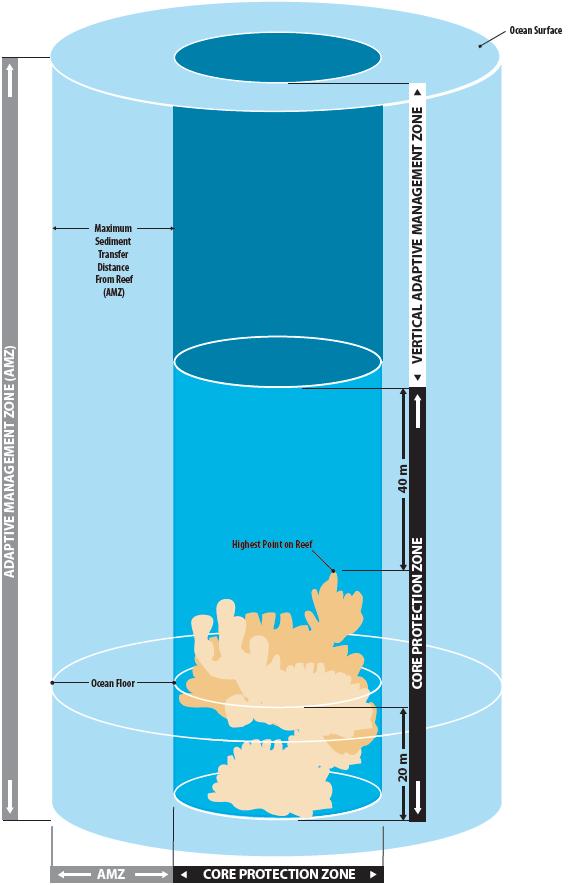
Zoning
Each glass sponge reef has a Core Protection Zone (two CPZ in the Central Reef), a Vertical Adaptive Management Zone and an Adaptive Management Zone.
The Core Protection Zones contain the sponge reefs and are designed to provide the highest level of protection to the reefs.
The Core Protection Zone consists of:
- the seabed
- the subsoil to a depth of 20m and the water column above the seabed to a depth of 100 m below the sea surface for the Northern Reef
- 120 m for the Central Reef (Zones A and B)
- 146 m for the Southern Reef
The Vertical Adaptive Management Zones consist of the water column that extends above the Core Protection Zones to the sea surface.
The Adaptive Management Zones consist of the seabed, subsoil and waters of the Marine Protected Areas (i.e., Northern, Central, and Southern Reefs) that are not part of the Core Protection Zones or the Vertical Adaptive Management Zones.
The regulations prohibit:
- carrying out any activity that disturbs, damages, destroys or removes any living marine organism or any part of its habitat or is likely to do so
- carrying out any scientific research or monitoring, or an educational activity, unless it is part of an activity plan that has been approved by the Minister
There are exceptions to these prohibitions that identify activities that may be allowed to occur in the MPA in certain zones. The following activities are allowed in the MPA:
- certain fishing activities in the adaptive management and vertical adaptive management zones. (Fishing activities will be managed in accordance with variation orders, regulations and license conditions in a manner consistent with the conservation objective of the MPA)
- navigation activities throughout the MPA; however, anchoring is not allowed in the core protection zones
- the laying, maintenance or repair of cables in the adaptive management zones
- activities carried out for public safety, public health, national defense, national security, law enforcement or in response to an emergency
- scientific research, monitoring and educational activities that have been approved by the Minister
All fishing, anchoring, and cable installation, maintenance and repair are prohibited in the core protection zones.
Fishing closures and other prohibitions
The Core Protection Zones are closed to all commercial, recreational, and Aboriginal fishing. Anchoring and cable installation, maintenance, and repair are also prohibited in the Core Protection Zones.
The Vertical Adaptive Management Zones and Adaptive Management Zones are currently closed to all commercial bottom contact fishing, as well as for midwater trawl. These closures will be in effect until further notice.
For more detail on the fishery closure within the Hecate Strait and Queen Charlotte Sound Glass Sponge Reef MPA, please review the FN0198 Fishery Notice.
You can find more information on fishery management in the Hecate Strait and Queen Charlotte Sound Glass Sponge Reef Marine Protected Area by reviewing the appropriate Integrated Fisheries Management Plans, and in the BC Sport Fishing Guide.
Activity plan application: Hecate Strait and Queen Charlotte Sound Glass Sponge Reefs Marine Protected Area (HS/QCS MPA)
Scientific research or monitoring, or educational activities are allowed in the HS/QCS MPA if a proponent submits an activity plan to Fisheries and Oceans Canada and it receives Ministerial approval.
Learn more about the activity plan process
Publications
- Hecate Strait/Queen Charlotte Sound Glass Sponge Reefs Marine Protected Area (MPA) annual report 2023
- Pacific Region Cold-Water Coral and Sponge Conservation Strategy (2010-2015) (PDF, 2.8 MB)
- Science At Sea Collaborative Research
- Dataset for all MPAs
- Date modified:

